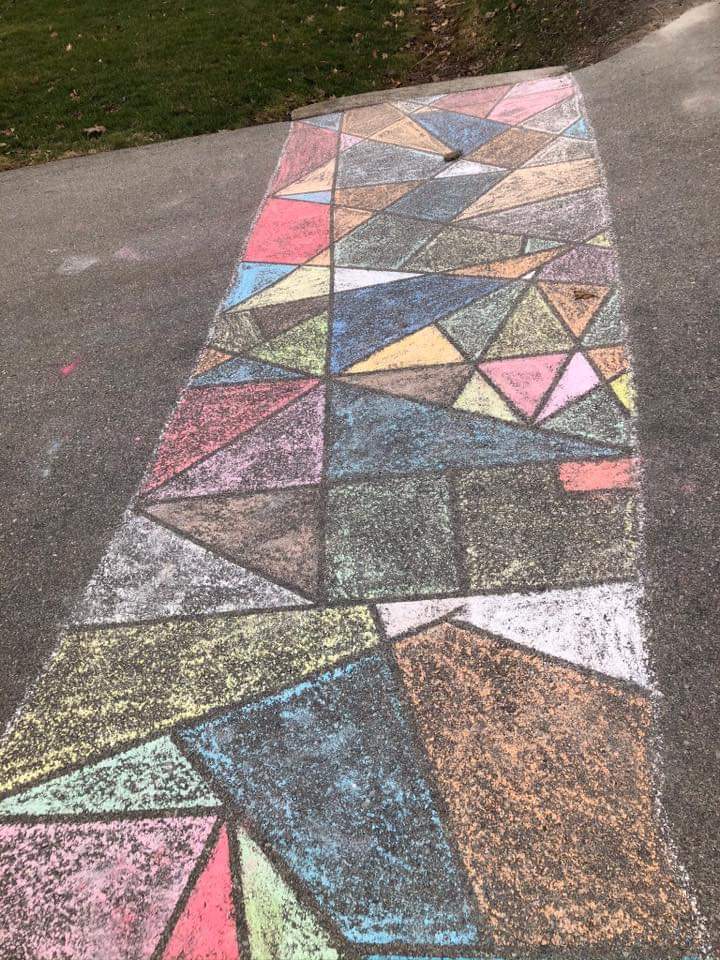The following blog post is from Oakville, Ontario Physiotherapist Kristina. She see’s many of our paediatric patients for “kids physio”. She is now available for virtual physio sessions for infants, kids, and adults of all ages! It’s like a video conference!
With social distancing being our current new norm, most facilities and parks are closed, gatherings banned, and usual activities not an option.
If you have chalk and a driveway… or a deck in the backyard… or if you live in an apartment or the weather doesn’t allow for outdoor play, you can substitute masking tape for chalk and put it directly on the carpet or floor…
Here are some ideas to be creative and get moving!
For Kids:
- Hopscotch: any variations you want, including single and double leg hops!
- Works balance, jumping, coordination, control
- Four Square: You may have to get everyone involved in this one. In a large square with four squares inside and a player in each. Player bounces the ball in their square and then hit it to another square to bounce only once as well. If a ball bounces in your square more than once, you’re out! Can be played with a catch and bounce pass or more of a dribble for older kids.
- Works aim and coordination
- Obstacle course: be creative and draw any variation you want. You can have a “balance beam” where you walk heel to toe, crawl spaces, frog jump or squat spaces, single and double leg hops, hop over obstacles, twirls, touch your toes, stand on one leg for a period of time, and you can even throw in some push ups, or jumping jacks, or burpees… You can have twists and turns in the course, or multiple pathways… Then time each other to compete!
- Can work balance, jumping, coordination, control, core and glut strength, and general gross motor skills
- Tic-tac-toe on the ground (using objects for your Xs and Os so that you can replay multiple times)
- Works puzzle and problem solving

- Alphabet Jump: draw out all the letters fairly close together, in any orientation or shape you want. Then, as the letters are called out, you can jump to different ones with one foot, both feet, alternating feet, or even frog jumps! Instead of someone calling out letters, players can spell out words! For older kids you can play this like TWISTER as well to incised the difficulty.
- Works balance, jumping, coordination, control, letter recognition and spelling skills!
- “Floor is Lava” or “Avoid the Shark”. Draw safe ground from the lava to jump onto, or islands in the sea to jump onto (there are sharks in the water)! Make it more challenging by slowly removing the islands or spacing them out differently. You can also draw different shapes / colours and change which ones are “safe” zones!
- Works balance, jumping, coordination

- Chalk Bull’s Eye: draw out concentric circles with bullseye in the middle. Each circle is worth a certain number of points, increasing toward the middle. This can be drawn on the ground, but also on the fence or on the wall of the side of the house. Then you can throw a ball, or water balloons, and see who gets the most points! Increase the difficulty by increasing distance, toss from 1 foot, use the non dominant hand to toss, start from a seated position.
- Works throwing, aim, math skills
- Chalk Maze: any variation and size you want, and you can time each other on how long it takes to run / hop / heel to toe walk to complete!
- Depending on the method of getting through the maze, but can work balance and jumping!
- Sidewalk twister: Use at least four different colours and four different shapes, then have someone call out where right and left hands and feet should go while players try to maintain their balance! You can get creative with the shapes – animals, stars, card symbols, etc.
- Works balance, coordination
- Long jump: just like with track and field. Use measuring tape to mark the feet (up to 12). Then, you can jump as far as you can from the line, or do a running jump.
- Works jumping
The above games are great to keep kids active but are also a way to improve gross motor skills!
Don’t let your kids have all the fun! All of these activities are beneficial for people of all ages. If hopping or jumping is difficult you can make modifications, it may also be a great opportunity to work on lost skills.
If you, as an adult have pain or difficulty participating in these activities with your kids, our Oakville based Physiotherapists are available via virtual physiotherapy to help explore this and get you going in the right direction. We are able to virtually treat people from anywhere in Ontario, and we are happy to help!
Adults can benefit too! Not only are these activities great for quality family time, but they can be also be used for your own general activity or specific rehab exercises. For example, if you are recovering from an ankle sprain, or knee injury, as swelling and pain decrease, you can start doing more advanced (and fun!) things to improve your balance, strength, and plyometric power and control.

Other examples, for both kids and adults, include:
- Agility ladder: similar to drills in soccer or football practice, you can draw a ladder about 20 feet long and divided into 20 squares. Then, you can choose from a variety of agility exercises, such as: in and outs, sidesteps, crossovers, side straddle hops, carioca steps, ickey shuffle, double trouble, etc. Start slow to ensure correct foot placement and pattern learning, then increase your speed more and more! Additionally, you can perform high knees, squat jumps, single and/or double leg hops.
- Walk the line: a long line can be drawn (or a narrow, long rectangle, as if “walking the plank”) where you can practice heel-to-toe walking forwards, backwards, eyes open or closed!
It is best to consult with a Registered Physiotherapist who can assess you virtually and provide a program that is specific to you and your goals! Most insurance companies now cover this type of physiotherapy as they recognize it to be just as effective as in-person physiotherapy.

